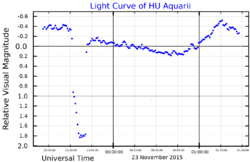Astronomy:HU Aquarii
| Observation data Equinox J2000.0]] (ICRS) | |
|---|---|
| Constellation | Aquarius |
| Right ascension | 21h 07m 58.19445s[2] |
| Declination | −05° 17′ 40.5577″[2] |
| Apparent magnitude (V) | +15.3 |
| Characteristics | |
| Spectral type | DAm / M4.5V |
| Variable type | AM Herculis |
| Astrometry | |
| Proper motion (μ) | RA: -64.579[2] mas/yr Dec.: -62.732[2] mas/yr |
| Parallax (π) | 5.2354 ± 0.0457[2] mas |
| Distance | 623 ± 5 ly (191 ± 2 pc) |
| Details | |
| Mass | 0.88/0.2 M☉ |
| Radius | 0.01/0.22 R☉ |
| Luminosity | 0.0022/0.0052 L☉ |
| Temperature | 12,500/3,400 K |
| Orbit | |
| Period (P) | 2.08 hours[3] |
| Semi-major axis (a) | 0.0032 au |
| Eccentricity (e) | 0.0 |
| Inclination (i) | 85° |
| Other designations | |
HU Aqr, RBS 1724, RE J210755-051621, 1RXS J210758.5-051744, 1AXG J210759-0518, 2RE J210755-051630, RE J2107-051, EUVE J2108-05.2, 2RE J2107-051, RX J2107.9-0518, AAVSO 2102-05, GSC 05200-00849, RE J2107-05, RX J2107.9-0517, 2MASS J21075818-0517404, Gaia DR2 6911950900211768704[4] | |
| Database references | |
| SIMBAD | data |
HU Aquarii (abbreviated HU Aqr) is an eclipsing binary system approximately 620 light-years away from the Sun,[2] forming a cataclysmic variable of AM Herculis-type. The two stars orbit each other every 2.08 hours[3] and the ultra-short binary system includes an eclipsing white dwarf and red dwarf.
Eclipse timing variations
The HU Aquarii binary system exhibits variations in the timing of the eclipses. Schwarz et al. (2009) note that the variations are too large to be caused by the Applegate mechanism, and are within the expected range of magnetic braking but 30 times too large to be caused by gravitational radiation alone. As an alternative explanation, they suggested that the variations might be caused by an object in orbit around the binary, causing it to move back and forth along the line-of-sight to the system.[5] In March 2011, Qian et al. claimed the presence of two planets,[6] though the proposed orbits were subsequently shown to be unstable[7] and on orbits determined from a more thorough and precise analysis of the observational data.[8] Indeed, it seems likely that the signal that was interpreted as being the result of planetary companions might be instead the result of not well-studied interactions between the white dwarf and its red dwarf companion: as of 2014 all proposed orbital solutions have been refuted and it appears that the full set of timing measurements is inconsistent with any 1, 2 or 3-planet system due to poor fits to the data and unstable orbital configurations.[9] With new data gathered by 2018, the existence of planetary system remains elusive, as no model fitting all observations can be made.[10]
See also
References
- ↑ Shengbang, Qian; Zhongtao, Han; Fernández Lajús, E; liying, Zhu; Wenping, Liao; Miloslav, Zejda; Linjia, Li; Voloshina, Irina et al. (July 2016). "Interactions between planets and evolved stars". Journal of Physics: Conference Series 728 (4): 042006. doi:10.1088/1742-6596/728/4/042006. Bibcode: 2016JPhCS.728d2006S.
- ↑ Jump up to: 2.0 2.1 2.2 2.3 2.4 2.5 Brown, A. G. A. (August 2018). "Gaia Data Release 2: Summary of the contents and survey properties". Astronomy & Astrophysics 616: A1. doi:10.1051/0004-6361/201833051. Bibcode: 2018A&A...616A...1G. Gaia DR2 record for this source at VizieR.
- ↑ Jump up to: 3.0 3.1 Howell (2002). "An Exploration of the Paradigm for the 2-3 Hour Period Gap in Cataclysmic Variables". The Astrophysical Journal 550 (2): 897–918. doi:10.1046/j.1365-8711.2002.05841.x. Bibcode: 2002MNRAS.336.1129B.
- ↑ V* HU Aqr -- CV of AM Her type (polar)
- ↑ Schwarz (2009). "Hunting high and low: XMM monitoring of the eclipsing polar HU Aquarii". Astronomy and Astrophysics 496 (3): 833–840. doi:10.1051/0004-6361/200811485. Bibcode: 2009A&A...496..833S.
- ↑ Qian, S.-B.; Liu, L.; Liao, W.-P.; Li, L.-J.; Zhu, L.-Y.; Dai, Z.-B.; He, J.-J.; Zhao, E.-G. et al. (2011). "Detection of a planetary system orbiting the eclipsing polar HU Aqr". Monthly Notices of the Royal Astronomical Society 414 (1): L16–L20. doi:10.1111/j.1745-3933.2011.01045.x. Bibcode: 2011MNRAS.414L..16Q.
- ↑ Horner, Jonathan; Marshall, J. P.; Wittenmyer, Robert A.; Tinney, C. G. (September 2011). "A dynamical analysis of the proposed HU Aquarii planetary system". Monthly Notices of the Royal Astronomical Society: Letters 416 (1): L11–L15. doi:10.1111/j.1745-3933.2011.01087.x. Bibcode: 2011MNRAS.416L..11H.
- ↑ Wittenmyer, Robert; Horner, J.; Marshall, J. P.; Butters, O. W.; Tinney, C. G. (February 2012). "Revisiting the proposed planetary system orbiting the eclipsing polar HU Aquarii". Monthly Notices of the Royal Astronomical Society 419 (4): 3258–3267. doi:10.1111/j.1365-2966.2011.19966.x. Bibcode: 2012MNRAS.419.3258W.
- ↑ M. Bours; T. Marsh; E. Breedt; C. Copperwheat; V. Dhillon; A. Leckngam; S. Littlefair; S. Parsons et al. (2014). "Testing the planetary models of HU Aquarii". Monthly Notices of the Royal Astronomical Society 445 (2): 1924–1931. doi:10.1093/mnras/stu1879. Bibcode: 2014MNRAS.445.1924B.
- ↑ Schwope, A. D.; Thinius, B. D. (2018), "On the ephemeris of the eclipsing polar HU Aquarii. II: New eclipse epochs obtained 2014–2018", Astronomische Nachrichten 339 (7–8): 540–544, doi:10.1002/asna.201813526, Bibcode: 2018AN....339..540S
Coordinates: ![]() 21h 07m 58.29s, −05° 17′ 39.4″
21h 07m 58.29s, −05° 17′ 39.4″
 |


